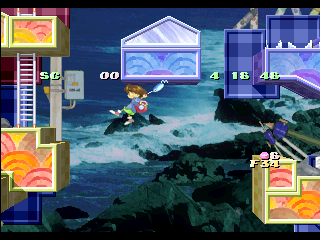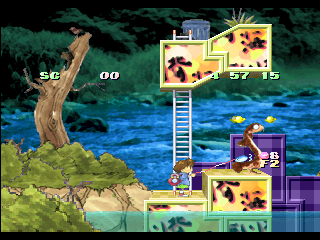Overview
Umihara Kawase Shun is the PlayStation sequel to the original Umihara Kawase on the SNES. Much like the original game, players take the role of the titular heroine as she navigates fish-infested levels by using her trusty fishing pole as a grappling hook. Incorporating rudimentary physics that take variables such as momentum and elasticity into consideration, completing many of the levels requires taking the fullest advantage of level geometry and manipulating the heroine's velocity so she can reach otherwise implausible areas. Unlike other editions of the game, Shun is unique in that it features in-game commercials that appear as interludes between some levels that promote various types of goods, not all of which are clearly related to the game's subject matter. The game was later re-released as Umihara Kawase Shun: Second Edition, featuring new levels and bug fixes, as well as a removal of the commercials.
Gameplay
 The game's heroine swinging across a wide gap.
The game's heroine swinging across a wide gap.The only tool available to the player's disposal in Umihara Kawase Shun is the iconic fishing rod. While it can be used to disable and remove enemy fish from the playing field, its primary purpose is for level traversal, with the end goal being to reach one of potentially several doors that will take the player to different levels depending on their location. To that end, the grappling hook is able to latch onto walls, floors, and ceilings, enabling the player to often swing around levels in places that would be impossible to reach solely by foot, with the most distant parts of the level often being reached with careful consecutive swings and well-timed fishing rod placement. In addition, velocity and momentum can be manipulated by changing the length of the fishing line, as well as by increasing tension on the line by rubbing it against corners of the level geometry. The fishing line itself can also be launched both on the ground and midair in eight different directions using the PlayStation's d-pad, with diagonal directions being assigned to the shoulder buttons on the controller.
While the emphasis in Shun's gameplay lies on level navigation, various obstacles are regularly placed in the game that try to impede progress. Initially, this lies primarily in the form of various fish and other sea creatures. While mostly docile, touching most types nonetheless results in a life lost, requiring the player to either reel them in with the fishing line to remove them from play or avoid them altogether. While the majority of such enemies are preset in the levels, certain types can also temporarily spawn on empty platforms if the player takes too long trying to moving from one end of an area to another. Beyond that, various traps exist in the more advanced levels that can also prove to be fatal. These can take the form of things such as spike pits, icy geometry onto which the grappling hook cannot latch, and disappearing floor and ceiling tiles, among other things.
 An enemy eel being defeated with the power of fishing.
An enemy eel being defeated with the power of fishing.Like the original game on the SNES, Shun operates on a timer. Not only does it limit how much time that the player can take in completing a level, but it also influences when, where, and how the game ends and the credits start rolling, as taking too much time will automatically trigger it once the player completes their last allotted level. The ending is further influenced by which levels the player decides to tackle based on the doors that they use to exit each level, with multiple paths towards the end existing depending on the route taken.
Log in to comment